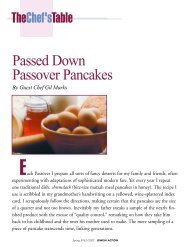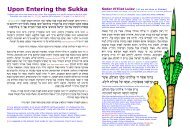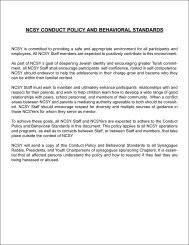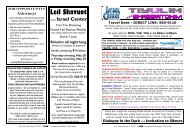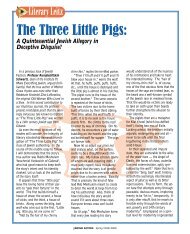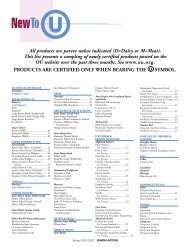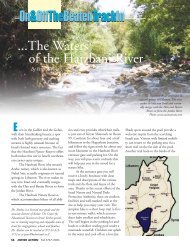welcoming jews with disabilities into jewish ... - Orthodox Union
welcoming jews with disabilities into jewish ... - Orthodox Union
welcoming jews with disabilities into jewish ... - Orthodox Union
You also want an ePaper? Increase the reach of your titles
YUMPU automatically turns print PDFs into web optimized ePapers that Google loves.
One of the most effective ways of<br />
connecting deaf Jews to the synagogue<br />
community is through a Shabbaton, an<br />
event that brings together deaf and<br />
hearing Jews for a warm Shabbat experience.<br />
“Since there are so few social<br />
and religious opportunities for deaf<br />
Jews, these events tend to attract deaf<br />
individuals from surrounding states,”<br />
says Rabbi Eliezer Lederfeind, director<br />
of Our Way, the OU’s program for the<br />
deaf and hearing impaired and the only<br />
program that hosts Shabbatonim for the<br />
Jewish deaf. Our Way is a division of<br />
NJCD. Our Way Shabbatonim are held<br />
several times a year at OU synagogues<br />
in various communities throughout the<br />
United States. “In shul, we usually<br />
interpret the tefillah and the rabbi’s<br />
speech. Most of the hearing Jews in the<br />
shul are amazed [to see] the signing,”<br />
says Rabbi Lederfeind. “They are<br />
astonished to find that so many deaf<br />
Jews are neighbors of theirs whom they<br />
have never met before.”<br />
Established in 1969, Our Way<br />
continues to provide the Jewish deaf<br />
and hard of hearing <strong>with</strong> resources and<br />
programming that puts them in touch<br />
<strong>with</strong> each other and <strong>with</strong> Jewish experiences<br />
formerly closed to this most isolated<br />
population. Through sign language<br />
publications, programs providing<br />
interpretation of synagogue services,<br />
interpreted classes, its Megillat Esther<br />
PowerPoint Presentation for Purim<br />
(used in numerous shuls across the<br />
country) and the Jewish Deaf Singles<br />
Registry matchmaking service, among<br />
other programs, Our Way continues to<br />
advance the quality of life for Jews who<br />
are deaf and hard of hearing.<br />
As the network of the Jewish deaf<br />
community grows, so does the concern<br />
for one another. Rabbi Lederfeind<br />
became acquainted <strong>with</strong> the Antar family,<br />
a deaf couple living in Alabama,<br />
while he was manning an Our Way<br />
booth at a convention for the deaf in<br />
Washington, DC. A horrific tragedy<br />
brought them closer. In November<br />
2002, terrorists committed a vicious car<br />
bomb attack on an Israeli-owned hotel<br />
in Mombasa, Kenya, killing three<br />
Israelis and wounding eighty<br />
others. Among the victims<br />
were the Antars’ nephews,<br />
Noy and Dvir, aged twelve<br />
and thirteen, of Ariel. Rabbi<br />
Lederfeind contacted the<br />
Antars to console them, and<br />
suggested a powerful way to<br />
pay tribute to their nephews:<br />
holding a Shabbaton linking<br />
the deaf and hearing communities,<br />
in memory of the<br />
boys. The Antars loved the<br />
idea and decided to host the<br />
Shabbaton in a sizable Jewish<br />
community; they chose<br />
Atlanta.<br />
Rabbi Chaim Neiditch,<br />
director of NCSY’s (National<br />
Conference of Synagogue<br />
Youth) Southern Region,<br />
assisted <strong>with</strong> the necessary<br />
arrangements and brought<br />
twenty NCSYers eager to join<br />
Congregation Beth Jacob in <strong>welcoming</strong><br />
the thirty deaf participants. “It was a<br />
great success,” says Rabbi Lederfeind.<br />
“The Antars spoke very movingly<br />
about their nephews. I told them,<br />
‘They brought the message of Shabbat<br />
to the deaf community in Atlanta.’”<br />
The Jewish deaf in Atlanta continue<br />
to maintain a connection to<br />
Congregation Beth Jacob and to the<br />
broader local Jewish community. Rabbi<br />
Neiditch has organized more Our Way<br />
programs at the shul. “The shul has<br />
become the home for Atlanta’s Jewish<br />
deaf community,” says Rabbi<br />
Lederfeind. “The local Purim parade<br />
even featured a presentation made by<br />
the deaf kehillah.” Plans for another<br />
Shabbaton are in the works.<br />
Who Gives Sight to the Blind<br />
A poignant teshuvah (responsum)<br />
of Rav Moshe Feinstein involves a<br />
blind man who needed a guide dog to<br />
accompany him to shul. Since a dog is<br />
not permitted in a synagogue, some<br />
posekim rule that a blind person is<br />
exempt from praying in shul. In his<br />
teshuvah, Rav Moshe expresses the concern<br />
that if an individual can’t bring a<br />
Leah and Louis Caplan, both of whom are deaf, met<br />
through the Jewish Deaf Singles Registry (JDSR). An<br />
international matchmaking service, JDSR, which is<br />
sponsored by Our Way, aims at pairing deaf Jewish<br />
singles of all ages, denominations and communication<br />
modalities. Sixty percent of the Jewish deaf population<br />
intermarry, out of desperation rather than indifference.<br />
The JDSR works to stem the tide of Jewish<br />
deaf assimilation.<br />
seeing-eye dog to shul, he won’t ever be<br />
able to participate in tefillah betzibbur<br />
or hear keriyat haTorah, and would feel<br />
completely isolated from the community.<br />
To preserve the person’s identity as a<br />
member of Klal Yisrael, Rav Moshe<br />
ruled that the man be allowed to<br />
attend shul <strong>with</strong> his guide dog.<br />
When social worker Chaim<br />
Biberfeld of Brooklyn introduced his<br />
guide dog, Vike, to the members of his<br />
minyan, a few of them warily kept<br />
their distance. “They’ve since gotten<br />
used to him,” says Biberfeld.<br />
Born <strong>with</strong> retinitis pigmentosa,<br />
the most common cause of blindness,<br />
Biberfeld did not realize he had a problem<br />
until he reached his teenage years.<br />
“I saw 20/20,” he explains, “but I<br />
lacked peripheral vision. It wasn’t until<br />
I bumped <strong>into</strong> enough people that I<br />
realized I’d better go see an eye doctor.”<br />
As the years progressed, his eyesight<br />
continued to deteriorate. He eventually<br />
took a course in mobility training and<br />
got a cane and a seeing-eye dog.<br />
“Starting out <strong>with</strong> a physical disability<br />
and becoming disabled later in life are<br />
very different experiences,” says<br />
Biberfeld. “I had to go through a series<br />
of stages—denial, anger, bargaining<br />
<strong>with</strong> God and, finally, acceptance. I<br />
56 JEWISH ACTION Fall 5766/2005



